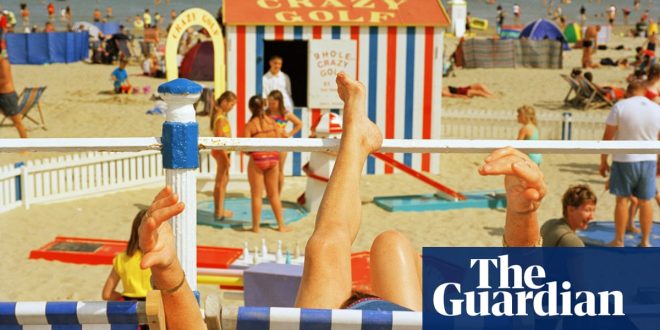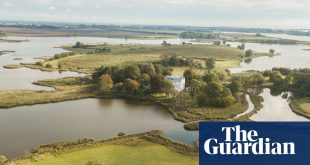Weymouth, Dorset
Photographer Martin Parr’s 1999 film Think of England captures the nostalgic appeal of Weymouth: roast dinners at seafront B&Bs, pensioners with cones of Mr Whippy, the carousel whirling to the familiar tune of the funfair organ. “It’s not a resort that needs a lot of razzmatazz,” says the man sitting in front of a “Sorry, No Vacancies” sign.
Since then Weymouth has hardly splashed into the 21st century. Behind the esplanade its pedestrianised shopping streets are flagged with To Let signs. And while its wide, sheltered beach is consistently voted among the nation’s favourites, the town itself is often overlooked in favour of its trendier seaside neighbours, from foodie Lyme Regis to on-the-up Bournemouth.
Still, Weymouth has all the elements of a classic British seaside holiday: donkey rides, Punch and Judy shows, sticks of rock. And the harbour, with its pretty tutti-frutti-coloured houses, is home to one of the best seafood restaurants in the country. Catch (four-course lunch from £40) opened in 2021 in the old fish market on the quay. Co-owner and chef Mike Naidoo started his career in a local chippie (and worked more recently in revered chef Jason Atherton’s kitchens). Here, he focuses on sustainably caught fish, usually from small day boats bobbing just outside.
In front of the restaurant is a fishmonger (Weyfish) and a takeaway (Hatch) for crab sandwiches. For ice-cream, deliciously retro Rossi’s Ices on the Esplanade is the classic, opened in 1937 by Fioravanti Figliolini: it makes only two or three flavours a day, to a secret family recipe.
The beach is beautiful, but offshore is just as big an attraction: Weymouth Bay has some of the best sailing waters in northern Europe and hosted the sailing events at the 2012 London Olympics and Paralympics. There’s no need for a boat licence to get out there: the Official Test Centre, next to the National Sailing Academy at the northern edge of the Isle of Portland, offers sports from wing foiling to paddleboarding overlooking the bay.
Where to stay Gloucester House (doubles from £159 B&B), a grand Georgian townhouse on the seafront, has 10 smartly decorated rooms, some with sea views and balconies.
Fiona Kerr
Tynemouth, Tyne and Wear
In the final decades of the last century Tynemouth appeared rather staid next to other north-east seaside resorts. While hen and stag parties and booze cruise Norwegians descended noisily on Whitley Bay and South Shields, Tynemouth (pronounced to rhyme with “south”) looked primly on, emitting – or so it seemed – a scent of mothballs, mildew and sweet sherry.
Though it has loosened up a fair bit since then and now embraces surfers, coffee-roasters, street food pop-ups, chocolatiers and micro pubs, the town still exudes a gracious charm. The sweeping Victorian crescent and Grand Hotel hint at a past of one-piece cozzies, parasols and thés dansants (tea dances); the abandoned 1920s saltwater lido (hopefully soon to be restored) and angular art deco frontage of the Tynemouth Park Hotel suggest fast cars and Bright Young Things. Visitors can take a – generally bracing – stroll out on the 900-metre pier that guards the northern mouth of the Tyne and stand so close to the slab-sided ships that pass through they could almost touch them.
Tynemouth shares the sweeping, golden Long Sands beach with Cullercoats, but has the perfection of King Edward’s Bay all to itself. Sheltered on three sides by cliffs, it is overlooked by the ruins of a Norman priory and the 16th-century fortifications of the Spanish Battery (the artillerymen were imported from the Iberian peninsula by Henry VIII, to protect his fleet – perhaps he didn’t trust the truculent Northumbrians). Reached by steep stairs, it’s the sort of perfect cove you can imagine the Famous Five picnicking in while investigating smugglers.
The little bay is the home of the now-celebrated Riley’s Fish Shack, which also owns Toast, a bar and bakery among the boutiques and bars of Front Street. Toast serves the sort of croque madame (a croque monsieur with an egg on top) that would get a thumbs up from even the most pernickety Parisian, with ale from one of Tyneside’s best breweries, Two by Two, to wash it down. On Saturdays and Sundays, a market spills out from the restored Victorian station, with stalls selling old postcards, vinyl, plants and relics from baby boomer childhoods. Coffee and pastries bought here can be eaten gazing out across the river to the sands of South Shields, beneath the statue of local lad Cuthbert Collingwood, a vice-admiral who partnered Lord Nelson at the Battle of Trafalgar.
Where to stay Number 61 Guest House is a seven-room B&B in an elegant Georgian townhouse on Front Street, with doubles from £95 B&B.
Harry Pearson
Oban, Argyll and Bute
Its nearest beach may be a two-mile stomp along the coast at Ganavan Sands – and a lovely sandy sweep looking out to the isles it is too – but Oban has everything else you might want from a Scottish seaside town: a whisky distillery, cracking seafood, a host of great walks and a ferry port for island-hopping. It’s a handsome town, not postcard pretty: stoic, granite Victorian villas climb the hillside above the esplanade, presided over by the colossal circular folly of McCaig’s Tower.
The ferry port is why most visitors pass through Oban, boarding CalMac vessels that cruise onwards to Mull, Iona, Tiree and further into the Hebrides. And while they will probably not miss the little green hut next to the terminal, which sells platters of shellfish to be devoured at picnic benches before sailing, they are missing out on much more.
For starters, Oban Distillery is one of the oldest (founded in 1794, it is still based in the same building) and smallest scotch distilleries in the country, with just two copper stills producing its single malt. But there has been a steady trickle of more recent arrivals too. Just around the corner, the Modern Croft is stocked with contemporary Scottish designers, including a number of makers from in and around Oban: graphic, alphabet-style prints by Lorna Freytag, linen aprons from Kames Farm, beautiful paper art from Kirsty Currie.
“There have been lots of improvements in town – including the community buyout of a local landmark building to develop the Rockfield Centre arts hub – helping it become a destination in its own right,” says the Modern Croft’s owner Isabella MacRitchie. “But there are also forests, sailing, hiking, cycling and watersports on our doorstep.”
Local community-led charity Adventure Oban, which works towards equal access to the surrounding great outdoors, last year created a host of new cycling trails around the back of Ganavan Sands as part of its Big Bike Weekend (look out for dates for this summer’s outing). Visitors can log their activities as part of the charity’s One Million Miles campaign, whether biking, paddling or hiking. “The Gallanach Circular walk is one of my favourites,” says Adventure Oban trustee Isla McCulloch. “It feels like you’re miles away when it’s actually quite close to town and the views are stunning.” Back on the main drag, George Street, Cuan Mor dishes up an afternoon fish tea and 16-hour beef brisket from its smoker, and the Oban Beer Seller is stacked with Isle of Eigg pale ale and bottles from Diggers Cider in Fife for a wee carry-oot.
Where to stay Witchwood House (doubles from £110 B&B, two-night minimum) has boldly decorated sea-view rooms. The design stakes on Oban’s seafront have been increased thanks to upmarket and relatively expensive sibling hotels No 17 The Promenade and No 26 By the Sea.
Fiona Kerr
after newsletter promotion
New Brighton, Merseyside
Seaside memories are handed down with cracked buckets and bendy spades. When I was very little, in the early 1970s, we used to go to Southport and Blackpool for days out – but my mum always talked about New Brighton. It signified her own childhood, before marriage, work, kids. But we never visited; it was as if she wanted to protect a memory.
I went last year, out of curiosity. It was a glorious, hot, cloudless day. I was with an old friend who was recovering from a major operation. We were struck by the casual drama of the front: the epic promenade; the castle on the corner – a defence battery built in the 1820s; the lighthouse; and the great sweep of the beach, with families and couples and dog walkers all spread out. Across the water, loomed the cranes and docks of Liverpool.
New Brighton’s tower was, at the time of its completion in 1900, the tallest structure in Britain, 15 metres higher than its 158m Blackpool rival. The views of the Isle of Man and Ireland must have been stupendous. It was demolished in 1919, but the ballroom survived, and the Beatles played there many times. Decline came to New Brighton after the second world war, and ferries to Liverpool stopped in 1971. Martin Parr evokes the spirit of 1980s northern England and its working-class visitors in his 1986 exhibition The Last Resort. As we bought cod and chips at Perch Fish Bar, I couldn’t help recalling his caricatures.
But back outside, the light was Mediterranean, and people were relaxed and friendly. Just up from the beach, on Victoria Road, was a villagey centre full of street art and independent retailers. Rockpoint Records has sprouted a tattooist, barbers and cocktail bar. We had a pint and strolled back to the bluff known as The Dips. We had walked for two hours, got tans and reminisced a lot.
New Brighton is nothing like “old” Brighton, “old” Southport, “old” Blackpool or “old” Morecambe. It has no fairground, arcades, theme parks, Airbnb madness, hordes of holidaymakers or hype; it just has views and space to think and breathe. Mum’s secret is intact. She would have been happy to see its decline in reverse, and the Wirral’s wide-open north shore so natural and normal and curiously liberating.
Where to stay On Victoria Road, a few minutes’ walk from the station, the New Brighton Hotel has doubles from £72 room-only (breakfast £10.95pp).
Chris Moss
Cromer, Norfolk
The north Norfolk coast laps up most attention for visitors seeking the seaside. But east, beyond Holkham, Wells, Cley and Sheringham, is Cromer, prettily perched on cliffs as the coast curves to the south. The fishing village became a fashionable seaside town in late Victorian times when the railway arrived but despite the perennially tasty Cromer crabs, the town’s fortunes waned in the latter half of the last century. Norfolk moves at its own pace (“slow you down” say road signs in these parts) and gentrification has reached the town relatively late. While newcomers renovate its elegant Victorian buildings, Cromer has not been Airbnb-brushed out of existence.
The town proudly holds on to the old-fashioned attractions that make it special: its fishing boats pulled on to the beach by rusty old tractors; its bespoke end-of-pier show (“where the West End comes to the seaside”); some raucous pubs as well as fancier food-oriented joints; and its affordable fish-and-chip shops and ice-creams.
One of the town’s chief advantages is that it can be reached by rail. It also has clean bathing waters and the best surf in Norfolk. There’s even the potential to explore the rich sea life of the chalk reef, which may be the largest such feature in Europe and is the source of great marine riches including its crabs (which are admittedly sadly diminished in size) and starts just 200 metres from the shore.
On the seafront, North Sea Coffee is a hip hangout, and runs North Sea Nights, where East Promenade is transformed into a late-night music venue once a month in summer. Norfolk tapas are served in large tipis at Sundown at The Grove.
My favourite Cromer day is to take the clifftop walk past the working lighthouse to Overstrand and return for fish and chips at Mary Jane’s or No. 1 Cromer, then a beer in the cosy Red Lion.
Where to stay The Cliftonville (doubles from £89 room-only) is a traditional clifftop hotel in a grand building which has recently been given a makeover. All rooms have sea views.
Patrick Barkham
 Top Naija News – Nigeria News, Nigerian News & Top Stories Top Naija News – Nigerian Newspapers, Nigerian News. topnaijanews is a daily Nigerian newspaper covering Latest News, Breaking News, Entertainment, Sports, Lifestyle and Politics.
Top Naija News – Nigeria News, Nigerian News & Top Stories Top Naija News – Nigerian Newspapers, Nigerian News. topnaijanews is a daily Nigerian newspaper covering Latest News, Breaking News, Entertainment, Sports, Lifestyle and Politics.




